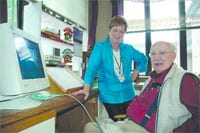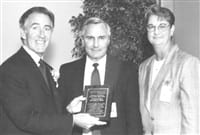Coming About Jewish Geratric Services Continues to Adapt as the Tide Turns in Elder Care
Lucy Giuggio RN, director of case management for Longmeadow-based Jewish Geriatric Services, often compares the organization to a ship. And the seniors the organization serves, she says, are the captains.
“There are a sea of options for seniors today,” she said, continuing the metaphor. “The challenge is identifying what the best option is for each person, and recognizing that changes … what’s good today may not be suitable tomorrow.”
To that end, JGS, which began in 1912 as a nursing home in Springfield called that Daughters of Zion Home for the Aged, has grown in its 95-year history to not only meet the needs of area elders, but also to predict those changes on the horizon.
“I spend a lot of time answering questions,” said Giuggio, “from seniors as well as their families and caregivers. When need arises, the first thing that comes to mind for most people is a nursing home. But part of my job is explaining that there is a continuum of care today to be utilized.”
Homeward Bound
Indeed, many people still equate JGS only with its nursing facility, the Julian J. Leavitt Family Jewish Nursing Home (JNH), a 200-bed facility that serves as the flagship for JGS at its Converse Street location. However, the JGS footprint is much larger than that, including several aspects of that continuum of care, a staff of more than 400, and an operating budget of $25 million.
In addition to JNH, the non-profit also operates Ruth’s House, a 76-bed assisted living facility; Genesis House, a 109-unit independent living facility; Spectrum Home Health Care, which offers home-based nursing and assistance services to residents in 10 towns, and the Wernick Adult Day Health Care Center, which provides daily acitivities and health assistance to seniors still living in their own homes.
Alan Rosenfeld, president and CEO of JGS, said keeping people in their own homes will be a driving force behind several new initiatives within the organization in the coming years, as JGS embarks on a new strategic planning phase this year.
“We’re looking very closely at home-based care and trying to create more opportunities for people that will allow them to stay in their own homes,” said Rosenfeld. “It goes back to our mission. We started as a nursing home, but our mission is much broader — to serve the elderly. We have no desire to bring people into a nursing home who do not need to be.”
The growing need for comprehensive care that caters to a wide range of seniors at various levels of independence and health is indeed a major focus for Rosenfeld and his team as JGS moves forward. Baby Boomers are aging, and that means all elder care facilities will be facing capacity issues in the next 20 to 30 years.
But more pressing, Rosenfeld said, is the World War II generation, which although markedly smaller than the Boomers, represents the population with the greatest need.
“The older Boomers are currently turning 60,” he explained. “But the generation that went through World War II — they’re turning 85. That’s the highest-demand population, although it is one that is shrinking.”
The strategy moving forward, then, becomes two-fold, added Rosenfeld — maintaining the quality of the nursing home as enrollment numbers dip, and refocusing attention on home and community services, in order to enter the next decade with a strong care model.
“Baby Boomers will begin turning 85 in 2030,” he told The HealthCare News. “And this idea of entering a nursing facility as one’s health declines, I don’t think they’re going to go for that.”
Diane Mintz, executive vice president for Spectrum Home Health Care, agreed with Rosenfeld that in terms of the broad makeup of care at JGS, Spectrum’s services will be very much at the forefront of new planning initiatives, because the home health agency often represents the entry point for seniors seeking assistance. That in turn can lead to a long-standing relationship with the organization as an elder’s needs change.
“Spectrum launched in 1994,” she explained, “which makes us relatively young — many visiting nurse services in the area are more than 130 years old. But in terms of our relationship to the entire campus, we represent a big part of the team. Our clinicians are seeing about 80 people a day, offering specific services including nursing care and rehab.
“And if extended care is necessary due to an acute illness or a fall, for instance,” added Mintz, “there are other services readily available within the same system. I think it’s comforting for people to know that everything is all right here.”
More importantly, though, Rosenfeld noted that Spectrum allows JGS to extend its services and its mission to a larger audience.
“We need to be able to address the needs of the aging population while at the same time keeping them independent longer, and we’re making progress in this area.”
Staying on Course
The work is multi-faceted — in addition to some program additions and enhancement, Rosenfeld said JGS’ new strategic plan, currently on the drawing board, is expected to include the creation of a privately operated Hospice program. Also planned are an expansion of home health services, a revamped approach to treatment services, particularly of chronic ailments such as Alzheimer’s Disease and diabetes, and an ongoing effort to streamline the many service aspects at JGS, so they work together as seamlessly as possible.
The new directions are an extension of similar initiatives taken on in recent years at JGS to address the varied needs of seniors. These include the addition of tele-medicine to home health care services, free-standing digital health diagnostic centers in every building on the JGS campus (residents swipe an ID card and can immediately check blood pressure, weight, and other variables), and a remodeling effort at Genesis House two years ago that added 29 units, new elevators, and a community kitchen and meeting room.
Prior to that project, though, was the notable construction of Ruth’s House assisted living eight years ago, and a renovation of JNH that made the facility more home-like.
Susan Halpern, director of development at JGS, said those projects were funded largely by a capital fundraising campaign called ReGeneration, which took place from 1995 to 1997 and raised more than $7 million.
“The ability to meet the changing needs of the elderly and to be able to adjust to a changing health care community were the driving forces behind that campaign,” she said, noting that as JGS embarks on new projects, the mission will remain largely the same.
The organization conducts an annual fundraising campaign, but also an annual donors’ night, complete with entertainment, and the Kinsler Classic, a bridge, tennis, and golf tournament, among other endeavors. Halpern said the events as well as the annual appeal allow JGS to maintain services and to develop new ones, but in the coming years she expects a greater focus on major gifts and planned giving, in preparation for new additions to the JGS suite of services.
“Part of my job is to educate the public on the challenges of providing quality care for elders,” she explained. “The task is very taxing on our system, because essentially we are being called upon more and more each year to provide more costly health care with fewer dollars.
“We are very blessed with a supportive community of donors who understand and embrace our mission,” she continued, “but there is a growing gap between funding and services, and the question becomes ‘where do we look to fill that gap?’”
Halpern said some of the options she’s experimented with have been some new media initiatives — billboards and other marketing tools that the organization had not used before. She also said JGS recognizes contributors whenever possible through events and inclusion in the community, and through a number of educational projects, meant to better translate the JGS mission to a greater number of people. Naming opportunities — from bricks in the walkway to entire builings on the JGS campus — remain a strong fundraising tool as well.
“We continually establish new budgets and try to reach new goals time and time again, in terms of major gifts and growing our endowment,” Halpern said of JGS’ fundraising objectives (the endowment currently stands at approximately $22 million). “What got us here today was our ability to remain fluid in terms of fundraising, but also in terms of the entire health care picture.”
Sailing Away
Giuggio agreed.
“We are a long-term care system that offers most levels of care that people need,” she said, “and that allows us to help others balance care with quality of life.
“I use the analogy of the sea a lot because of the many options we provide for the elderly,” she continued, “but also because we provide a sort of telescope for them … the ability to sail through those options, and find the best possible outcome.”
Jaclyn Stevenson can be reached at stevenson@healthcarenews.com



Comments are closed.